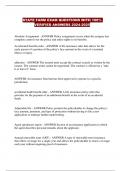Summary
Summary A Level Edexcel Biological Psychology Notes (with Full A* Essay Plans)
- Course
- Institution
Complete notes on Biological Psychology for Edexcel with Full A star essay plans, colour coded to ensure you get all AO1, AO2, AO3 points
[Show more]












